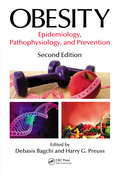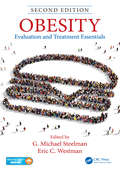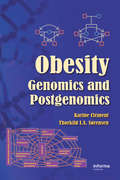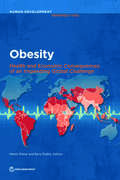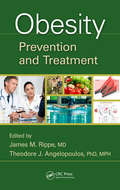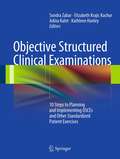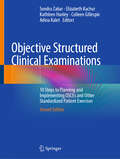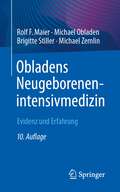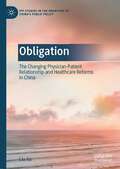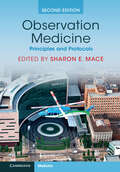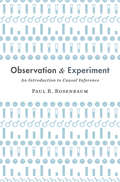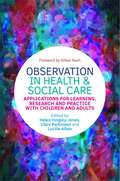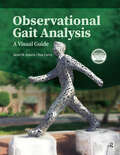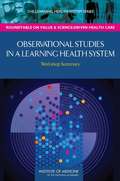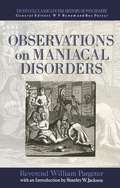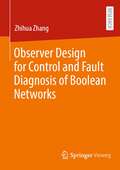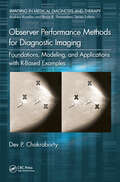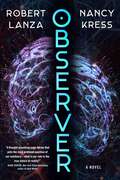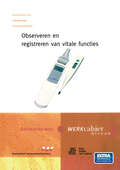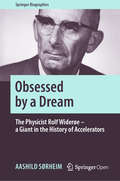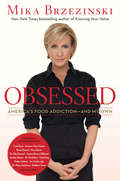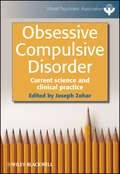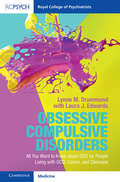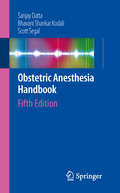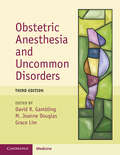- Table View
- List View
Obesity: Epidemiology, Pathophysiology, and Prevention, Second Edition
by Harry G. Preuss Debasis BagchiThe World Health Organization (WHO) has declared obesity a global epidemic. Its prevalence has more than doubled since 1980, causing a myriad of health problems for children and adults. Obesity: Epidemiology, Pathophysiology, and Prevention, Second Edition explores the molecular mechanisms and pathophysiology leading to obesity and metabolic disord
Obesity: Evaluation and Treatment Essentials, Second Edition
by Eric Westman G. SteelmanAddressing a growing epidemic in today's world, Obesity: Evaluation and Treatment Essentials presents practical treatment protocols for obesity, including exercise, pharmacology, behavior modification, and dietary factors, from the point of view of the practicing physician. <P><P> Encompassing a multidisciplinary audience of clinicians and researchers, this comprehensive resource is an invaluable, user-friendly tool for bariatric physicians and surgeons, endocrinologists, diabetologists, nutritionists, dieticians, and all those who treat obesity.
Obesity: Genomics and Postgenomics
by Karine ClémentThis book comprehensively accounts the current understanding of genetic mechanisms of obesity by analyzing obesity phenotypes and genotypes and, gene polymorphisms and mutations, and current results from animal model research and genetic studies in human models. By presenting the impact of genetic factors in the development of obesity and key molec
Obesity: Health and Economic Consequences of an Impending Global Challenge (Human Development Perspectives)
by Meera Shekar and Barry PopkinObesity is a global ticking time bomb with huge potential negative economic and health impacts, especially for the poor. As of 2016, an estimated 44 percent of adults (more than two billion) worldwide are overweight or obese, and over 70 percent of them live in low- or middle-income countries, dispelling the myth that obesity is a problem only in high-income countries. The global obesity epidemic presents a formidable challenge to human capital acquisition, national wealth accumulation, and the goals of ending extreme poverty and boosting shared prosperity. Given the renewed global focus on human capital, its links to the obesity epidemic, and the growing evidence base for double- and triple-duty actions, there is both an urgent need for action and a great opportunity for engagement that will require both a whole-of-government and a whole-ofdevelopment-partner approach. Countries and global partners need to act urgently to address this ensuing epidemic, with emphasis on interventions that require corrective public action rather than one of individual responsibility.
Obesity: Prevention and Treatment
by James M. Rippe Theodore J. AngelopoulosThe prevalence of obesity in the United States and the rest of the industrialized world has skyrocketed in the past 20 years. Linked to heart disease, diabetes, hypertension, and metabolic syndrome, it is also the leading cause of osteoarthritis and the second leading cause of cancer. With contributions from leading experts in the field, Obesity: P
Objective Structured Clinical Examinations
by Elizabeth Kachur Adina Kalet Kathleen Hanley Sondra ZabarObjective structured clinical examinations/exercises (OSCEs) using standardized patients (SPs) are an efficient means of surveying a diverse range of ability at any point along the continuum of medical education. An OSCE station can address multiple competency assessments across undergraduate, graduate, and continuing medical education. Nevertheless, organizing and enacting OSCEs is a major undertaking and, as with most other educational projects, collaborating within and across specialties and disciplines only enriches the process. The production of an effective OSCE program requires strong leaders committed to the benefits of such assessments, as well as many individuals to plan, prepare, and implement the program. To address the need for general guidelines of best practice and consistent organizational stratagem, Objective Structured Clinicl Exams is a comprehensive how-to manual for OSCE implementation. It contains an overview of and criteria for best practice, a review of relevant literature, insight into the program's influence throughout the healthcare system, and techniques for fine-tuning existing programs. Accompanying charts, graphs and sample forms are included to make this book the single resource for any educator interested in creating or improving a standardized patient program.
Objective Structured Clinical Examinations: 10 Steps to Planning and Implementing OSCEs and Other Standardized Patient Exercises
by Elizabeth Kachur Adina Kalet Kathleen Hanley Sondra Zabar Colleen GillespieObjective Structured Clinical Examinations (OSCEs) or other Standardized Patient/Participant (SP) exercises are an important methodology for teaching and assessment in health professions education across disciplines and the continuum of training. The first edition of Objective Structured Clinical Examinations offered a systematic approach for educators to get involved in the process of creating OSCEs and similar SP exercises. The second edition uses the same successful format to make the OSCE process easy and reproducible and adds novel material and innovative best practices for OSCEs in every context. The first edition of this book was based on the editors&’ 20 years of experience producing OSCEs without a clinical skills center — in empty classrooms or walk-in clinics on weekends, working with well-trained SPs and using carefully designed clinical scenarios. In the 10 years since, they have engaged in multidisciplinary and inter-professional collaborations and expanded their approach to designing and implementing successful performance-based assessment, both inside and outside of high-tech simulation centers. The original chapters - (1) Introduction; (2) 10-step approach; (3) Remediation; and (4) Unannounced Standardized Patients – have been updated and charts, tables and best practices throughout these chapters are elaborated and expanded on. This second edition also features an updated Foreword by Ronald Harden and Preface by Mack Lipkin, Adina Kalet, and Sandy Zabar, along with eight new chapters in collaboration with other educators and researchers, covering topics such as: analyzing OSCE notes for clinical reasoning; OSCE data, reporting and visualization; scholarship and a research registry; examples of performance-based assessment in practice; virtual OSCEs and telemedicine skills; OSCEs for transitions; OSCEs for teaching; and SP programs. This expanded edition will be useful to both novice and advanced educators and offers an important contribution to the health professions education literature.
Obladens Neugeborenenintensivmedizin: Evidenz und Erfahrung
by Rolf F. Maier Michael Obladen Brigitte Stiller Michael ZemlinDieses Buch zeigt Neonatologen, Pädiatern, Geburtshelfern, Pflegenden und Hebammen wie die intensivmedizinische Versorgung von Früh- und Reifgeborenen adäquat gelingt. Themen sind u.a. Erstversorgung, Beatmung, Blutgasanalyse, Sauerstofftherapie, Ernährung, Diagnostik und Therapie pulmonaler, kardialer, renaler, neurologischer und metabolischer Erkrankungen sowie Pharmakotherapie des Neugeborenen. Viele Tipps und Tricks helfen Fallstricke und Gefahrensituationen zu erkennen und somit zu vermeiden. Ein praxisorientiertes Buch auf hohem wissenschaftlichen Niveau zum schnellen Nachschlagen und kompetenten Handeln bei Früh- und schwerkranken Reifgeborenen. Die 10. Auflage erscheint komplett überarbeitet und aktualisiert.
Obligation: The Changing Physician-Patient Relationship and Healthcare Reforms in China (IPP Studies in the Frontiers of China’s Public Policy)
by Liu JiaThis book explores the shifting nature of physician–patient relationship in China. Specifically, it takes the physician–patient relationship during the barefoot doctor program in 1968–1978, the marketization of healthcare in 1978–2002, and the healthcare reform in 2003–2020 as three historical periods, illustrating how the nature of the physician–patient relationship has changed over time. Analyzing the ways in which law and social policies—involving the doctrine of informed consent, public hospital reform, and systemic healthcare reform—have in different ways shaped and changed the practices of physicians and patients, which illustrates how the bond between them threatens to collapse. With a uniquely vivid depiction of Chinese healthcare issues, this book will interest sociologists, China scholars and more.
Observation Medicine: Principles and Protocols
by Sharon E. MaceUsing comprehensive sample administrative and clinical protocols, this fully updated and practical second edition guide to observation medicine (OM) provides a detailed account of how to establish and run an observation unit (OU) and reviews medical/surgical/obstetrical-gynecologic/psychiatric/social conditions in which OM may be applicable. The book covers clinical topics including improving patient outcomes, avoiding readmissions, and using OM in a pandemic or disaster. Practical topics on design, staffing, and daily operations; fiscal and business aspects, such as coding, billing, and reimbursement; regulatory concerns such as aligning case management and utilization review with observation; nursing considerations are all present. The new edition features many new chapters and topics ranging from the geriatric OU, psychiatric observation, telemedicine in OM, to the cancer patient in the OU. Applicable to an international audience, it offers instructions for implementing observation in any setting or locale and in any type of hospital or other appropriate facility.
Observation and Experiment: An Introduction to Causal Inference
by Paul R. RosenbaumIn the face of conflicting claims about some treatments, behaviors, and policies, the question arises: What is the most scientifically rigorous way to draw conclusions about cause and effect in the study of humans? In this introduction to causal inference, Paul Rosenbaum explains key concepts and methods through real-world examples.
Observation in Health and Social Care: Applications for Learning, Research and Practice with Children and Adults
by Lucille Allain Stephen Briggs Claire Kent Gillian Ruch Andrew Cooper Graham Music Helen Hingley-Jones Clare Parkinson Dr Duncan Mclean Dr Pat Cartney Minna DaumExamining and exploring new approaches to therapeutic observation in health and social care, this multidisciplinary guide discusses and analyses its uses in a range of practical contexts with children, families and adults. Developing good observation skills is paramount to sustaining relationships in the challenging settings that health and social care professionals find themselves in. This guide shows how observation is taught, applied in practice, and how it will be returned to throughout professionals' careers. Drawing on psychoanalytic ideas and theories of human development as a base for professional learning, the experienced editors and authors offer theoretically informed models to teach observation skills in professional programmes, helping their readers prepare for successful intervention in any setting.
Observational Gait Analysis: A Visual Guide
by Janet Adams Kay CernyObservational Gait Analysis: A Visual Guide is a pedagogical manual and video library that provides a thorough review of key characteristics of normal gait that are important for observational clinical gait analysis.This visual guide by Drs. Jan Adams and Kay Cerny has unique features to further the understanding of examination and evaluation of the subject’s gait, such as: Normal and pathological gait are described using figures and graphs, along with gait videos and 3D graphs to show the kinematics and kinetics described Functional tools used as outcome measures to evaluate gait performance in the community environment including Dynamic Gait Test, Six Minute Walk Test, Ten Meter Walk Test, to name a few In addition to the unique features, the pathological gait section presents descriptions of gait deviations included in a new clinical Observational Gait Analysis (OGA) tool, along with probable causes for each of the deviations. Case studies are presented using this new tool for examining and evaluating the subject’s gait. Bonus!Students will be able to watch antero-posterior and lateral videos of individuals with gait deviations, complete the OGA tool to document their gait examination, and evaluate their examination results. They will then validate their observational skills by comparing their results to the text’s case study OGA results and the skeletal model and motion and moment graphs completed by 3D instrumented analysis of the same individual. The student will then compare their evaluation of causes of deviations to that included in the case study. Included with the text are online supplemental materials for faculty use in the classroom.Observational Gait Analysis: A Visual Guide will be the go-to resource for clinical tools to analyze gait for physical therapy and prosthetic and orthotic students and clinicians, as well as other professionals interested in the clinical analysis of persons with gait disability.
Observational Studies in a Learning Health System
by Institute of Medicine Joe Alper Roundtable on Value and Science-Driven Health Care Claudia Grossmann A Learning Health System ActivityClinical research strains to keep up with the rapid and iterative evolution of medical interventions, clinical practice innovation, and the increasing demand for information on the clinical effectiveness of these advancements. In response to the growing availability of archived and real-time digital health data and the opportunities this data provides for research, as well as the increasing number of studies using prospectively collected clinical data, the Institute of Medicine\'s Roundtable on Value & Science-Driven Health Care convened a workshop on Observational Studies in a Learning Health System. Participants, including experts from a wide range of disciplines - clinical researchers, statisticians, biostatisticians, epidemiologists, health care informaticians, health care analytics, research funders, health products industry, clinicians, payers, and regulators - explored leading edge approaches to observational studies, charted a course for the use of the growing health data utility, and identified opportunities to advance progress. Workshop speakers and individual participants strove to identify stakeholder needs and barriers to the broader application of observational studies. Observational Studies in a Learning Health Systemis the summary of the workshop. This report explores the role of observational studies in the generation of evidence to guide clinical and health policy decisions. The report discusses concepts of rigorous observational study design and analysis, emerging statistical methods, and opportunities and challenges of observational studies to complement evidence from experimental methods, treatment heterogeneity, and effectiveness estimates tailored toward individual patients.
Observations on Maniacal Disorder
by Reverend William PargeterFirst Published in 1989. Current interest in the history of psychiatry is growing rapidly both among the psychiatric profession and social historians. This new series is designed to bring back into print many classic documents from earlier centuries. Each reprint has been chosen for the series because of its social and intellectual significance, and includes a substantial introduction written by an eminent scholar in the history of psychiatry. This volume contains ‘Observations on Maniacal Disorders’, by William Pargeter (1760-1810), and reflects change in therapeutic philosophy.
Observer Design for Control and Fault Diagnosis of Boolean Networks
by Zhihua ZhangBoolean control networks (BCNs) are a kind of parameter-free model, which can be used to approximate the qualitative behavior of biological systems. After converting into a model similar to the standard discrete-time state-space model, control-theoretic problems of BCNs can be studied. In control theory, state observers can provide state estimation for any other applications. Reconstructibility condition is necessary for the existence of state observers. In this thesis explicit and recursive methods have been developed for reconstructibility analysis. Then, an approach to design Luenberger-like observer has been proposed, which works in a two-step process (i.e. predict and update). If a BCN is reconstructible, then an accurate state estimate can be provided by the observer no later than the minimal reconstructibility index. For a wide range of applications the approach has been extended to enable design of unknown input observer, distributed observers and reduced-order observer. The performance of the observers has been evaluated thoroughly. Furthermore, methods for output tracking control and fault diagnosis of BCNs have been developed. Finally, the developed schemes are tested with numerical examples.
Observer Performance Methods for Diagnostic Imaging: Foundations, Modeling, and Applications with R-Based Examples (Imaging in Medical Diagnosis and Therapy)
by Dev P. Chakraborty"This book presents the technology evaluation methodology from the point of view of radiological physics and contrasts the purely physical evaluation of image quality with the determination of diagnostic outcome through the study of observer performance. The reader is taken through the arguments with concrete examples illustrated by code in R, an open source statistical language." – from the Foreword by Prof. Harold L. Kundel, Department of Radiology, Perelman School of Medicine, University of Pennsylvania "This book will benefit individuals interested in observer performance evaluations in diagnostic medical imaging and provide additional insights to those that have worked in the field for many years."– Prof. Gary T. Barnes, Department of Radiology, University of Alabama at Birmingham This book provides a complete introductory overview of this growing field and its applications in medical imaging, utilizing worked examples and exercises to demystify statistics for readers of any background. It includes a tutorial on the use of the open source, widely used R software, as well as basic statistical background, before addressing localization tasks common in medical imaging. The coverage includes a discussion of study design basics and the use of the techniques in imaging system optimization, memory effects in clinical interpretations, predictions of clinical task performance, alternatives to ROC analysis, and non-medical applications. Dev P. Chakraborty, PhD, is a clinical diagnostic imaging physicist, certified by the American Board of Radiology in Diagnostic Radiological Physics and Medical Nuclear Physics. He has held faculty positions at the University of Alabama at Birmingham, University of Pennsylvania, and most recently at the University of Pittsburgh.
Observer: A Novel
by Nancy Kress Robert LanzaObserver, by Robert Lanza and Nancy Kress is a slick, modern, hard science fiction standalone medical thriller, combining classic Robin Cook with the hard edge of Black Mirror and Altered Carbon.After neurosurgeon Caro Soames-Watkins’s career has gone down in flames, she receives a strange job offer from Nobel Prize-winning scientist Sam Watkins, a great uncle she barely knows, and desperation overcomes any suspicions.Watkins’s mysterious medical facility conducts research into the nature of consciousness, reality, and life after death. Two obstacles stand in his way: an intel leak and his failing body may not last long enough for the tech to be ready.As danger mounts, Caro finds more than she bargained for: murder, love, and a deep disturbing look into the nature of reality.At the Publisher's request, this title is being sold without Digital Rights Management Software (DRM) applied.
Observeren en registreren van vitale functies: Werkcahier Kwalificatieniveau 3, Basiszorg deel 3 (Skillslab-serie)
by Geerard Siereveld Johan van 't Wout Cees Van StipdonkObserveren en registreren van vitale functies: Werkcahier Kwalificatieniveau 3, Basiszorg deel 3 (Skillslab-serie)
Obsessed by a Dream: The Physicist Rolf Widerøe – a Giant in the History of Accelerators (Springer Biographies)
by Aashild SørheimThis Open Access biography chronicles the life and achievements of the Norwegian engineer and physicist Rolf Widerøe. Readers who meet him in the pages of this book will wonder why he isn't better known. The first of Widerøe's many pioneering contributions in the field of accelerator physics was the betatron, the second, the linear accelerator, both summarized in a 27 page PhD. The betatron revolutionized the fields of cancer treatment through radiation therapy and also nondestructive testing; hospitals worldwide installed Widerøe's machine and today’s modern radiation treatment equipment is based on his inventions. The most recent renaissance of the linac provides unprecedented x-ray intensities at Free Electron Laser (FEL) facilities in operation and construction worldwide. . Widerøe’s story also includes a fair share of drama, particularly during World War II when both Germans and the Allies vied for his collaboration. Widerøe held leading positions in multinational industry groups and was one of the consultants for building the world's largest nuclear laboratory, CERN, in Switzerland. He gained over 200 patents, received several honorary doctorates and a number of international awards.The author, a professional writer and maker of TV documentaries, has gained access to hitherto restricted archives in several countries, which provided a wealth of new material and insights, in particular in relation to the war years. She tells here a gripping and illuminating story.
Obsessed: America's Food Addiction--and My Own
by Mika BrzezinskiMika Brzezinski is at war against obesity. 'On Morning Joe,' she is often so adamant about improving America's eating habits that some people have dubbed her "the food Nazi. " What they don't know is that Mika wages a personal fight against unhealthy eating habits every day, and in this book she describes her history of food obsession and distorted body image, and her lifelong struggle to be thin. She believes it's time we all learned to stop blaming ourselves, and each other, and look at the real culprits-the food we eat and our addiction to it. Mika feels the only way to do this is to break through the walls of silence and shame we've built around obesity and food obsessions. She believes we need to talk openly about how our country became overweight, and what we can do to turn the corner and step firmly onto the path of health. So Mika made a deal with her very close friend Diane: they would work together on this book and on their personal goals, to help Diane drop 75 pounds and to break Mika's obsession with staying superthin. As she did in her bestseller 'Knowing Your' 'Value,' Mika has packed each chapter with insights from notable people in medicine, health, business, the arts, and politics. Singer Jennifer Hudson, the late writer and director Nora Ephron, TV host Gayle King, New Jersey governor Chris Christie, and many others open up to Mika about their own challenges and what works for them when it comes to food and diet. It's time we stopped whispering the F-word ("fat") the way we used to shun the C-word ("cancer"). This book-with its trademark Brzezinski smarts, honesty, and courage-launches us into a no-holds-barred conversation with family and friends, in schools and kitchens, in Congress and the food industry, to help us all find ways to tackle one of the biggest problems standing between us and a healthier America.
Obsessive Compulsive Disorder
by Joseph ZoharA clear summary of what is known about a highly prevalent and debilitating disorder that affects nearly as many people as does asthma. Expert authors review the biological basis for the disorder and describe both pharmacological and psychological approaches to treatment.
Obsessive Compulsive Disorder: All You Want to Know about OCD for People Living with OCD, Carers, and Clinicians (Royal College of Psychiatrists)
by Lynne M. Drummond Laura J. EdwardsObsessive compulsive disorder affects between 1 and 3 per cent of the population. Ranging from relatively mild symptoms to being a profoundly disabling disorder, it is a condition that is amenable to modern treatments. This book examines the evidence for and potential role of a range of treatment methods, from CBT to pharmacological approaches. It asks what an individual can do to help themselves, and how friends and relatives can assist in the recovery process. Although firmly based in clinical research, it is written in a jargon-free and accessible style to help provide deep understanding of the disorder. Personal narratives and case studies of people living with OCD feature to illustrate points, and the book considers emerging research and the future of approaches to OCD. Built upon decades of experience, this guide will inform and support adults and young people living with OCD, as well as carers, families and health professionals.
Obstetric Anesthesia Handbook
by Scott Segal Bhavani Shankar Kodali Sanjay DattaWritten by a highly regarded expert in the field of obstetric anesthesia Handy point of care Up-to-date information on the subject Good board review tool
Obstetric Anesthesia and Uncommon Disorders
by M. Joanne Douglas David R. Gambling Grace LimA thoroughly revised third edition of the acclaimed textbook for caregivers involved in the management of pregnant women with uncommon diseases or an unusual or rare condition. The book offers valuable case reports and experience collated by an international team of editors and contributors who are leading experts in the field. This edition contains five additional chapters covering topics like cardiac and neuraxial point of care ultrasound, substance abuse, rare inherited conditions, and anesthesia for rare fetal and placental conditions. Clear, concise management guidelines and algorithms are provided, and each chapter is written from the viewpoint of the obstetric anesthesiologist. Numerous tables, figures and photographs provide visual aids and each chapter contains valuable clinical insights highlighting the essential facts. Featuring updated figures and references, links to useful websites for further reading and a list of commonly used abbreviations. A valuable resource for obstetric anesthetists, perinatologists and other obstetric care providers.
